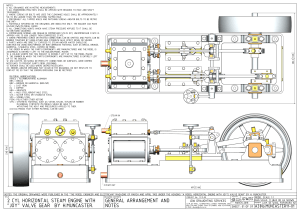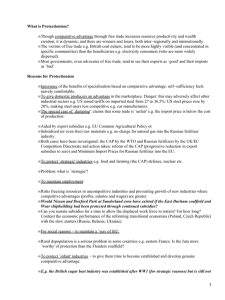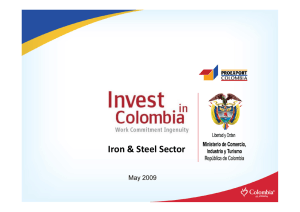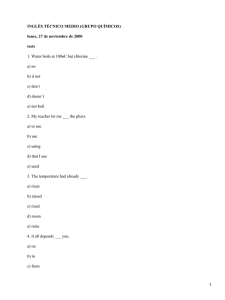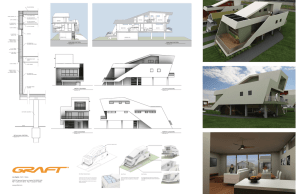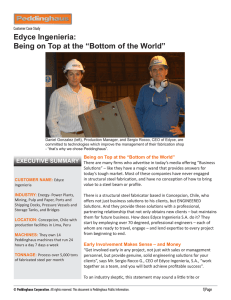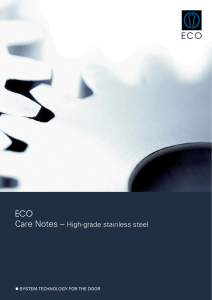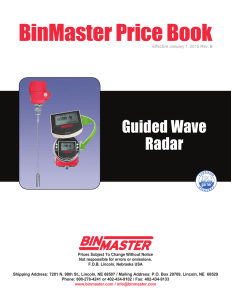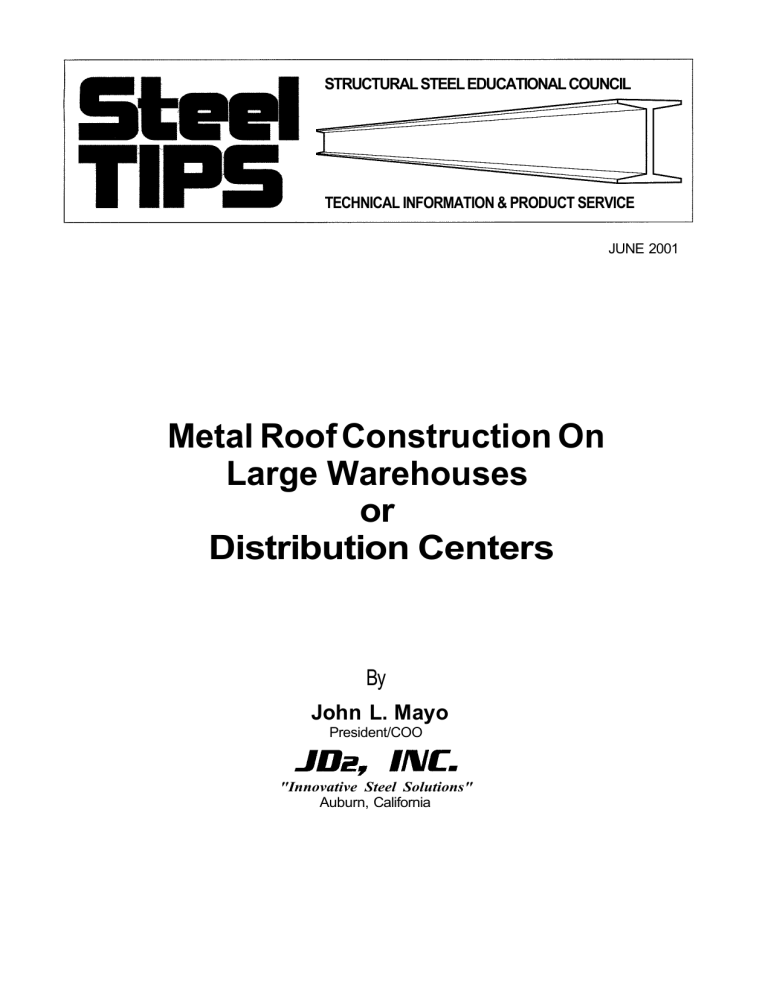
STRUCTURAL STEEL EDUCATIONAL COUNCIL TECHNICAL INFORMATION & PRODUCT SERVICE JUNE 2001 Metal Roof Construction On Large Warehouses or Distribution Centers By John L. Mayo President/COO "Innovative Steel Solutions" Auburn, California ACKNOWLEDGMENTS The authors wish to thank the following members of the Structural Steel Educational Group: James J. Putkey Larry McLean Verco Manufacturing, Inc. Disclaimer. The information presented in this publication has been prepared in accordance with recognized engineering principles and is for general information only. While it is believed to be accurate, this information should not be used or relied upon for any specific application without competent professional examination and verification of its accuracy, suitability, and applicability by a licensed professional engineer, designer, or architect. The publication of the material contained herein is not intended as a representation or warranty on the part of the Structural Steel Educational Council or of any other person named herein that this information is suitable for any general or particular use or of freedom from infringement of any patent or patents. Anyone making use of this information assumes all liability arising from such use. Caution must be exercised when relying upon other specifications and codes developed by other bodies and incorporated by reference herein since such material may be modified or amended from time to time subsequent to the printing of this publication. The Structural Steel Educational Council and the authors bear no responsibility for such material other than to refer to it and incorporate it by reference at the time of the initial printing of this publication. Metal Roof Construction on Large Warehouses or Distribution Centers, John L. Mayo, Steel Tips, June 2001 1 METAL ROOF CONSTRUCTION ON LARGE WAREHOUSES OR DISTRIBUTION CENTERS By John L. Mayo Table of Contents Page Introduction .................................................................................................... 3 Erection Speed .................................................................................................... 4 Safer Construction .............................................................................................. 4 Cost Savings .................................................................................................... 5 1. Diaphragm Capacities ...................................................................... 5 2. Wall Bracing ..................................................................................... 5 3. Panel Chord and Ledgers ................................................................. 6 4. Connections ..................................................................................... 7 Other Factors ...................................................................................................... 8 1. Insulation ........................................................................................... 8 2. Pre-finished Coatings .......................................................................10 3. Bay Sizes ..........................................................................................10 4. Light Refraction .................................................................................11 5. Special or Extra Loads ......................................................................11 6. lnsurance ..........................................................................................11 7. Steel is a Recyclable Resource ........................................................11 8. Steel is Insect Proof ..........................................................................11 9. Parapet Requirements ......................................................................11 10. Sprinklers ..........................................................................................11 11. Stability .............................................................................................12 12. Snow Loads ......................................................................................12 13. Acoustical .........................................................................................12 About the Author ...................................................................................................13 Metal Roof Construction on Large Warehouses or Distribution Centers, John L. Mayo, Steel Tips, June 2001 2 INTRODUCTION If you are currently designing or planning a large warehouse or distribution facility, this Steel Tips should interest you. Depending on your client's needs, code requirements and location, you may have a choice between using a plywood roof system or a metal decking roof system. The debate to use plywood or metal decking in roof construction has been quite common in recent years. However, over the past decade the development of the "hybrid" system utilizing open web steel joists with shop attached wood nailers and field applied plywood sheathing has become a popular choice. One of the key factors influencing this choice is the apparent value due to the slightly less initial cost for the plywood option. But you should look beyond the initial cost and investigate additional factors to ensure your client is, in fact, receiving the best overall value. Since the early 90's this hybrid system of open web steel joists combined with plywood sheathing has gradually taken over from the former popular choice of the glulam beam and solid wood purlin plywood sheathing system. While this hybrid system appears to allow fast erection and low cost, it is incumbent on the designer to carefully investigate all cost facets. Metal Roof Construction on Large Warehouses or Distribution Centers, John L. Mayo, Steel Tips, June 2001 3 ERECTION SPEED Metal deck projects such as the recently completed Target Distribution Facilities in Woodland, California and Albany, Oregon, each close to a million square feet in size, utilized an innovative new full-bay panelizing system comprised of assembled steel joists and bridging. Full-bay panelizing has been utilized for decades, but recent improvements and innovative new ideas have dramatically improved the efficiency of this process. The metal deck panelizing system involves spacing out an entire bay of joists on the ground and installing the complete bridging system (usually "X" bridging). These "lifts" are typically assembled adjacent to or in the same bay as their final location and may be stacked. A "crane bay" is established (usually every third bay) that allows the crane to back across the building and pick the bay in which it is positioned along with the two adjacent bays. Crews can prepare enough lifts in advance of the crane to allow erection of as much as 50,000 square feet of framing per day. This method substantially surpasses the plywood "hybrid" method for speed, safety and value. SAFER CONSTRUCTION The metal deck panelizing system enables the bridging to be installed on the ground prior to hoisting by a crane. All final connections of the framing are made out of lift baskets. This eliminates the need for workmen to walk the steel frame until the decking is spread. This also means that no loads are placed on the joist framing until all bridging is installed, which is in strict accordance with the latest OSHA and Steel Joist Institute requirements. The wood roof system typically does not install any of the bridging until after the roof substrate is in place and the joists have been loaded. Metal Roof Construction on Large Warehouses or Distribution Centers, John L. Mayo, Steel Tips, June 2001 4 COST SAVINGS 1. Diaphragm Capacities Metal decking diaphragms can resist substantially greater lateral forces than a wood diaphragm. The maximum shear capacity available with ½" plywood is about 800 pounds per linear foot. The most typical steel roof deck is 1-½" deep Type "B" deck, which is readily available in even gauges from 16 to 22 gauge. Odd gauges, such as 19 gauge are also available if in large quantities. The maximum shear value for "B" deck can be as high as 2420 pounds per linear foot, more than three times that of wood. Typically the weld pattern and gauge is designed in decreasing requirements from the shear walls or collector lines into the center of the zone where the shears are minimum. Working out the economics of heavier deck and greater weld pattern gives the owner the choice of fewer shear walls or interior braced frame elements. As an example, the Northern California Distribution Facility in Dixon, California is a 300,000 square foot warehouse originally designed and issued for bids as a plywood "hybrid" system. An alternate metal deck system was proposed and accepted, which eliminated an interior braced frame element that had been required with the plywood option. The ability to provide greater diaphragm capacity allowed distribution of lateral forces out to the perimeter tilt-up panels without need for interior bracing. Elimination of these interior brace lines provides savings in the structure costs and also substantial savings with the deletion of the associated grade beams in the foundation. The alternate metal deck system not only saved money and time, but also opened up the interior space as originally desired by the owner. 2. Wall Bracing It is becoming more common that project conditions allow the use of the metal deck to provide lateral support for the out-of-plane forces from the concrete tilt-up panels. This simply means the metal deck can support both the vertical gravity loads and also laterally brace the perimeter panels. On many projects, calculations can be provided based on rational analysis that confirms the ability of the metal deck to resist the combined axial and bending loads. Utilizing this approach allows the elimination of wall bracing that typically occurs at the ends of the building. This can save substantial costs in fabrication, erection and a dramatic reduction in the construction schedule. The evaluation of gauge metal roof deck acting as compression struts or ties to resist out-of-plane lateral wall forces is based on prescriptions of the Load and Resistance Factor Design for Cold Formed Steel Structural Members, March 16, 1991, published by The American Iron and Steel Institute. These prescriptions are included in the 1997 Uniform Building Code. The metal deck profile and configuration must be fully evaluated for axial and bending forces. The combined stresses due to bending and axial compression or axial tension are derived using effective section properties. The calculation of the effective sections for cold-formed gauge members is an iterative process based upon gross section profiles and material strength. Metal Roof Construction on Large Warehouses or Distribution Centers, John L. Mayo, Steel Tips, June 2001 5 The major metal deck manufacturers are equipped to provide automated analysis of member section properties and associated strut and tie capacities of specific metal deck profiles and configurations. As an example, the IKEA Distribution Facility is a two million square foot project in Tejon Ranch, California. By utilizing the combined axial and bending capacity of the metal roof deck, designers eliminated thousands of costintensive angle braces. At locations where the out-of-plane forces were exceptionally high, an additional line of joists were added, parallel to the wall to cut the initial deck span from 8'-0" to 4'-0". The addition of just thirteen joists along one shear wall eliminated 690 costly wall braces. This not only provided substantial savings back to the owner, but also cut dramatic time off the fabrication and erection schedule. 3. Panel Chord and Ledgers Strong consideration should be given to the choice of how the roof joists connect to the precast panels. A substantial benefit has been established utilizing individual "discrete" joist seats, wet set in the panels with a relatively small ledger angle between each seat to pick-up the diaphragm transfer from the metal deck into the panel. This would be used in lieu of the continuous channels often used in the wood hybrid system. The continuous channel designs usually use the capacity of the channel to act as the chord design of the panel. This channel often becomes costly to detail, difficult to produce fast enough to suit construction schedules and cost intensive to set and field weld together. The use of individual seats allows much faster production, easier placement into the panel pours and overall less cost. Reinforcing bars will be required in the panels to suit chord tie requirements, the cost of which is more than offset by the savings in the discrete seat method. Metal Roof Construction on Large Warehouses or Distribution Centers, John L. Mayo, Steel Tips, June 2001 6 4. Connections A. Framing. There are two standard options of connecting open web framing to either structural steel framing or to other open web framing. These options are either two bolts (¾" diameter for longspan and girders or ½" diameter for shortspan joists) or single pass fillet welds, most typically W fillet weld by 2" long on each side of the bearing shoe. The Steel Joist Institute sets these standards. On some projects it may be cost effective for the erector to select the bolted option for all framing connections, which can provide greater speed and safety of erection. Bolted options do not require slip critical design or minimum torque levels and can be satisfied with simple snug-tight soft bolts. When designating connections on the construction documents, it is best to specify both options for erector's choice. There will be instances where collector forces will be required to pass from one element to the next and welding will be necessary at these locations, since connection holes in shoes are slotted and are unable to provide lateral transfer. Transfer of lateral forces can be handled through the bearing shoes up to a maximum of approximately 12 kips for longspan joists and 25 kips for joist-girders. Forces greater than these should be transferred using "tie-plates" designed appropriately for the required forces. It is best to categorize these force levels into groupings of approximately 40 kips in order to provide simplicity in the field without penalizing the plate designs. All welding should be limited to single pass (5/16" thick) to avoid multipass welding, which may require special inspection requirements. Tie-plates can be elongated to suit required length of welds to satisfy transfer force. Bridging is typically bolted "X" bridging. There may be conditions where welded horizontal bridging is required, such as uplift restraint. The joist manufacturer and erector, to maximize efficiency, should carefully review and may be able to minimize the bridging by combining requirements. B. Decking. Historically, the most common method of connecting metal deck to steel framing has been by plug welding. Recently, the development and dramatic improvements in the use of power actuated pinning has provided a more cost effective and substantially faster option. I.C.B.O. reports are now available for a variety of pinning options that not only save time and money, but also provide a better quality of production with less skilled labor. Apprentices are able to install qualified pins at rates of five to eight times that of plug welding by seasoned ironworkers. It also avoids the unsightly discoloration of the plug welding from the underside. The sidelap attachments are done with buttonpunching, screwing or a combination of clinching and seam welding. The seam welding process should be avoided if possible due to its multiple step procedure and the high demand on quality control. It may be best to option for heavier gauge decks with lesser sidelap requirements if possible. Metal Roof Construction on Large Warehouses or Distribution Centers, John L. Mayo, Steel Tips, June 2001 7 To establish the lowest cost system, it is necessary to make an economic study considering relative values of deck gauges, labor, equipment and pin costs of various diaphragm schemes to maximize efficiency. Typical Roof Deck Profile Sidelap Attachments OTHER FACTORS As in the design of any project there are many factors to consider. What may appear to be at first a lower cost does not always prove to be the best choice. Some factors that should be taken into account may be: 1. Insulation With steel roof deck it is necessary that the insulation be placed on top of the deck as a substrate for the roofing. This is the best application of insulation since: • There is an uninterrupted envelope of insulation without the multiples of gaps inherent with batt insulation used with wood roofs. Metal Roof Construction on Large Warehouses or Distribution Centers, John L. Mayo, Steel Tips, June 2001 8 • All of the steel framing and decking is contained within the insulation at the room temperature; this insures a minimum of expansion and contraction. • The position of the vapor barrier can be maintained at the designed location. With batt insulation, the vapor barrier quite often occurs in the plywood, resulting in deterioration of the plywood and/or wood purlins. Unfortunately, this type of deterioration is not found until substantial failure occurs in the substrate with cases of rotting framing falling to the ground that had been hidden by the insulation. • Another drawback to batt insulation is the long-term maintenance costs for periodical re-attachment, a non-issue for the metal deck system. Metal Roof Construction on Large Warehouses or Distribution Centers, John L. Mayo, Steel Tips, June 2001 9 2. Pre-finished Coatings There are a variety of optional coatings available: Galvanized: Painted: G40 Light coating of galvanizing at slightly less cost. Suitable for larger projects only due to longer lead time for special coil. (Relative cost = .97) G60 Standard and most common coating. This product is readily available from all manufacturers. (Relative cost = 1.00) G90 Heavy coating of galvanizing only used for special conditions. Suitable for larger projects only due to long lead time for special coil. (Relative cost = 1.03) Single coat of grey paint over cold rolled. This is a primer only. Coating is subject to discoloration and stains. Field touch-up or final painting required if exposed. (Relative cost = .92) Single coat of white paint over cold rolled. This is not considered a finished coating and is subject to discoloration and stains. Field touch-up or final painting required if exposed. (Relative cost = .94) Single coat of white paint over galvanized. This is not considered a finished coating but will not discolor or stain. Field touch-up or final painting required if exposed. (Relative cost = 1.10) Double coat of paint over galvanized. This would be considered a final coating and would require special handling including shipping "softeners" to avoid scratching and marks. This is the most expensive option and should be carefully analyzed for economics. Field touch-up may be required. (Relative cost = 1.20) 3. Bay Sizes Inherently, plywood roofs are designed based on the standard 8'-0" plywood module. Quite often this is modified to 8'-01/8" to allow for expansion and contraction. This limitation tends to result in bay sizes in a multiple of 8'-0" with the 1/8" increment a nuisance to contend with. Since steel decking is custom rolled to length to fit the particular job, and the steel roof framing of open-web girders and joists are custom fabricated to fit, there are no limitations as to bay widths or lengths with steel roofs. For example, if a project would benefit with dimensions based on clear between columns, it can be simply done. Metal Roof Construction on Large Warehouses or Distribution Centers, John L. Mayo, Steel Tips, June 2001 10 4. Light Refraction A big advantage of metal decking over wood sheathing is the ability of the metal decking to provide substantially greater light refraction capabilities. A combination of skylights with either the galvanized or painted finish can provide sufficient light during daylight hours to turn off interior lighting. This power saving option was recently utilized at the Nestle's Distribution Facility in Lathrop, California during the recent and ongoing power crisis. 5. Special or Extra Loads If the project requires, the roof-framing module for steel roof decking can be easily modified bay-to-bay to accommodate special or extra roof loads such as mechanical equipment or roof screens. 6. Insurance Depending on the occupancy and insurance requirements, use of a steel roof deck over steel framing may show substantial insurance coverage savings. 7. Steel is a Recyclable Resource Steel is recyclable and the quality is consistent. 8. Steel is Insect Proof Wood is subject to infestation from insects and microscopic organisms, which is of special concern in any biotech application. Steel is insect proof. 9. Parapet Requirements With steel roof decking, the requirement for extended parapets may be eliminated. Under Factory Mutual requirements parapets may be required if a wood roof deck is used. 10. Sprinklers Where ceilings occur and all materials above the ceiling including the metal roof deck are incombustible, sprinkling the attic space may possibly be eliminated with the resulting substantial savings. Metal Roof Construction on Large Warehouses or Distribution Centers, John L. Mayo, Steel Tips, June 2001 11 11. Stability Steel roof deck is stable throughout its life without long-term deflection or shrinkage. This means the design capabilities, both vertical and horizontal have not deteriorated over time. 12. Snow Loads If the project is located where snow loads govern, usually the steel deck will carry the extra load without change in gauge, whereas most often, the wood roof decking must be increased at additional costs. 13. Acoustical If the project needs or would benefit from some acoustical treatment to reduce noise, this can easily be accommodated with steel deck simply by use of perforated acoustical roof deck of the same gauge and profile without losing any diaphragm shear capacity. After the deck is laid, the roofer installs strips of pre-cut batt insulation, as furnished by the deck manufacturer, in the ribs before installing the flat insulation panels as part of the roofing. Noise reduction coefficient of up to .80 may be obtained. Acoustical Vertical Webs Perforated With 5/32" Diameter Holes Staggered 7/16" C/C Insulation Strips in Low Flutes Field Installed Absorption Coefficients 125 250 500 1000 2000 4000 Noise Reduction Coefficient .60 .99 .92 .79 .43 .23 .80 Reprinted with permission from Verco Manufacturing Co., Inc. Every project involves unique issues and challenges. The designer should consider all aspects of cost, safety and speed when choosing a system. What can often appear to be cost effective in the short term, may not be the best overall value. If you have any questions or need further information please feel free to call the Structural Steel Educational Council. Metal Roof Construction on Large Warehouses or Distribution Centers, John L. Mayo, Steel Tips, June 2001 12 ABOUT THE AUTHOR John L. Mayo is a Civil Engineering graduate from the University of Maine and began working in the steel joist and metal deck industry in 1980 with Mclean Steel of Hayward, California. John spent 13 years with Mclean Steel as a detailer, project manager and Vice-President before starting his own firm with partner Don Jeffrey in 1993 called JD2 Inc. JD2, Inc. has offices in Sacramento, San Francisco, San Diego and Los Angeles. They are a steel construction subcontractor specializing in design-build projects providing complete steel packages, including erection. They have developed many connections and methods that are now considered industry standards and are currently pioneering the first commercial use of a Special Truss Moment Frame (STMF) system called TruFrame. JD2, Inc. can be visited on their Website at jd2inc.com. Metal Roof Construction on Large Warehouses or Distribution Centers, John L. Mayo, Steel Tips, June 2001 13 STRUCTURAL STEEL EDUCATIONAL COUNCIL P.O. Box 6190 Moraga, CA 94570 Tel. (925) 631-1313 Fax. (925) 631-1112 Fred Boettler, Administrator Steel tips may be viewed and downloaded at www.aisc.org S P O N S O R S Adams & Smith Four Star Erectors PDM Strocal, Inc. Bannister Steel, Inc. Gayle Manufacturing Plas-Tal Manufacturing Co. Baresel Corp The Herrick Corporation Reno Iron Works Bethlehem Steel Corporation Hoertig Iron Works SME Industries Bickerton Industries, Inc. Junior Steel Co. Shollenbarger-Borello, Inc. Bostrum Bergen McLean Steel Inc. Templeton Steel Fabrication California Erectors Martin Iron Works, Inc. Verco Manufacturing, Inc. Eagle Iron Construction Nelson Stud Welding Co. Vulcraft Sales Corp. Trade Arbed Oregon Steel Mills Western Steel & Metals, Inc. Eandi Metal Works The local structural steel industry (above sponsors) stands ready to assist you in determining the most economical solution for your products. Our assistance can range from budget prices and estimated tonnage to cost comparisons, fabrication details and delivery schedules. Funding for this publication provided by the California Iron Workers Administrative Trust.
